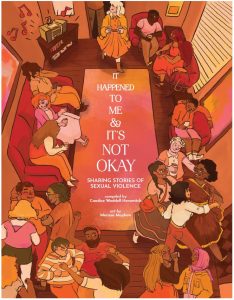It Happened to Me and it’s Not Okay: Sharing Stories of Sexual Violence
It happened to me & It’s not okay: Sharing Stories of Sexual Violence
This graphic novella is a free resource. Absolutely no distribution or editing of the resource can occur without written permission.
For permission please contact: waddellc@brandonu.ca
In order to make this resource free, our artist Merissa Mayhew is not receiving any royalties for her illustrations. If you loved the graphic novella as much as we did, please consider contributing to “Tip the Artist” to acknowledge her incredible work. The link below will take you directly to Merissa Mayhew’s portfolio. and has no affiliation to Brandon University or the Brandon University Student Union.
https://www.merissa.art/
To see the graphic novel, please click on the front cover below.
Overview: Ten interviews with individuals that have experienced sexual violence were used to create the narrative within this graphic novella. All ten individuals experienced some form of sexual violence while they were in post-secondary education. The graphic novella uses composite narrative to take the original ten stories from these individuals and compile them into one story with 4 different voices. The voices are compiled in a way that the original stories are anonymized, so the characters that are represented within this graphic novel are not representative of any of the original participants. In the story, there are 4 characters talking about their own personal experiences of sexual violence to the 5th character who has just experienced some form of unwanted sexual activity. Overall, the five characters in this graphic novella could be anyone, but the stories they are sharing are the experiences of people with a history of sexual violence.
Acknowledgements
This project would not have been possible without the participants of this research study: Alex, Britany, Danika, Darlene, Dawn, Ellen, Grace, Jessica, Joy, and Zara. Even if those that read this story will never know your identity, your story will be known forever more in the pages of this novella.
Design and consultation team included: Ana Iervolino (SERC Program Evaluation and Research); Jessica Laxdal (BU Sexual Violence Education and Prevention Coordinator), Merissa Mayhew (Graphic Artist); Chris Romaniuk (Sexuality and Reproductive Health Facilitator Youth); Curt Shoultz (BU Director of the Centre for Teaching, Learning, and Technology); Ashley Taron (Executive Director of Brandon University Student Union), Linden Haubrick (BUSU Vice President Engagement), Candice Waddell-Henowitch (Project Lead, Associate Professor Department of Psychiatric Nursing, BU).
References
[1] Lee, C., & Wong, J. S. (2019). A safe place to learn? Examining sexual assault policies at Canadian public universities. Studies in Higher Education, 44(3), 432–445. https://doi.org/10.1080/03075079.2017.1371687
[2] Martin-Storey, A., Paquette, G., Bergeron, M., Dion, J., Daigneault, I., Heber, M., & Ricci, S. (2018). Sexual violence on campus: Differences across gender and sexual minority status. Journal of Adolescent Health, 62, 701-707. https://doi.org/10.1016/j.jadohealth.2017.12.013
[3] Statistics Canada. (2013). Measuring violence against women: Statistics trends. https://www150.statcan.gc.ca/n1/pub/85-002-x/2013001/article/11766-eng.htm
[4] National Sexual Violence Resource Centre, (2013). Engaging bystanders to prevent sexual violence. Retrieved from: https://www.nsvrc.org/sites/default/files/2013-08/publications_nsvrc_bulletin_engaging-bystanders-prevent-sexual-violence_0.pdf
[5]World Health Organization. (2017). Violence against women. https://www.who.int/news-room/fact-sheets/detail/violence-against-women
[6] Henry, N., & Powell, A. (2016). Technology-facilitated sexual violence: A literature review of empirical evidence. Trauma, violence, and abuse 19(2), 195-208. https://doi.org/10.1177/1524838016650189
[7] Lonsway, K. A., & Fitzgerald, L. F. (1994). Rape myths: In review. Psychology of Women Quarterly, 18(2), 133–164. https://doi.org/10.1111/j.1471-6402.1994.tb00448.x
[8] Baugher, S. N., Elhai, J. D., Monroe, J. R., & Gray, M. J. (2010). Rape myth acceptance, sexual trauma history, and post-traumatic stress disorder. Journal of Interpersonal Violence, 25(11), 2036–2053. https://doi.org/10.1177/0886260509354506
[9] RAINN, (2024). What consent looks like. Retrieved from: https://www.rainn.org/articles/what-is-consent
[10] Davis, K. C. (2019). “Stealthing”: Factors associated with young men’s nonconsensual condom removal. Health Psychology, 38(11), 997–1000. https://psycnet.apa.org/doi/10.1037/hea0000779
[11]Ebrahim, S. (2019). I’m not sure this is rape, but: An exposition of the stealthing trend. Reproductive Health in Sub-saharan Africa, 9(2), 1–11. https://doi.org/10.1177/2158244019842201
[12] Allagia, R., & Wang, S. (2020). “I never told anyone until the #metoo movement”: What can we learn about sexual abuse and sexual assault disclosure through social media? Child Abuse & Neglect, 103, Article 104312. https://doi.org/10.1016/j.chiabu.2019.104312
[13] Delker, B. C., Salton, R., McLean, K. C., & Syed, M. (2020). Who has to tell their trauma story and how hard will it be? Influence of cultural stigma and narrative redemption on the storying of sexual violence. PLOS ONE, 15(6), 1–21. https://doi.org/10.1371/journal.pone.0234201
[14] Lanthier, S., Du Mont, J., & Mason, R. (2018). Responding to delayed disclosure of sexual assault in health settings: A systematic review. Trauma, Violence, & Abuse, 19(3), 251–265. https://doi.org/10.1177/1524838016659484
[15] Ullman, S. E., O’Callaghan, E., Shepp, V., & Harris, C. (2020). Reasons for and experiences of sexual assault nondisclosure in a diverse community sample. Journal of Family Violence, 35, 839–851. https://doi.org/10.1007/s10896-020-00141-9

